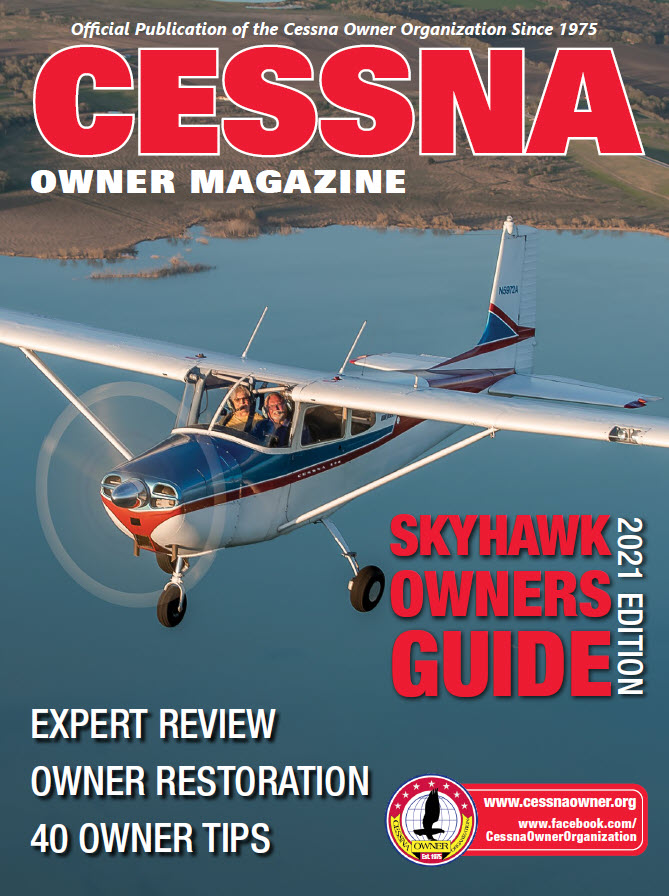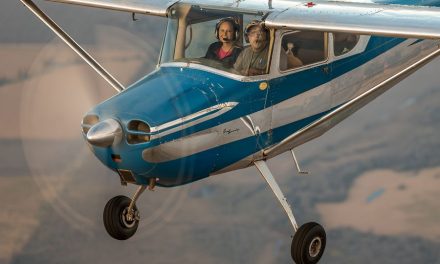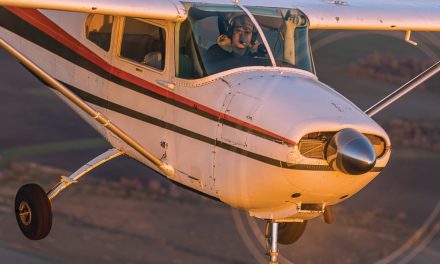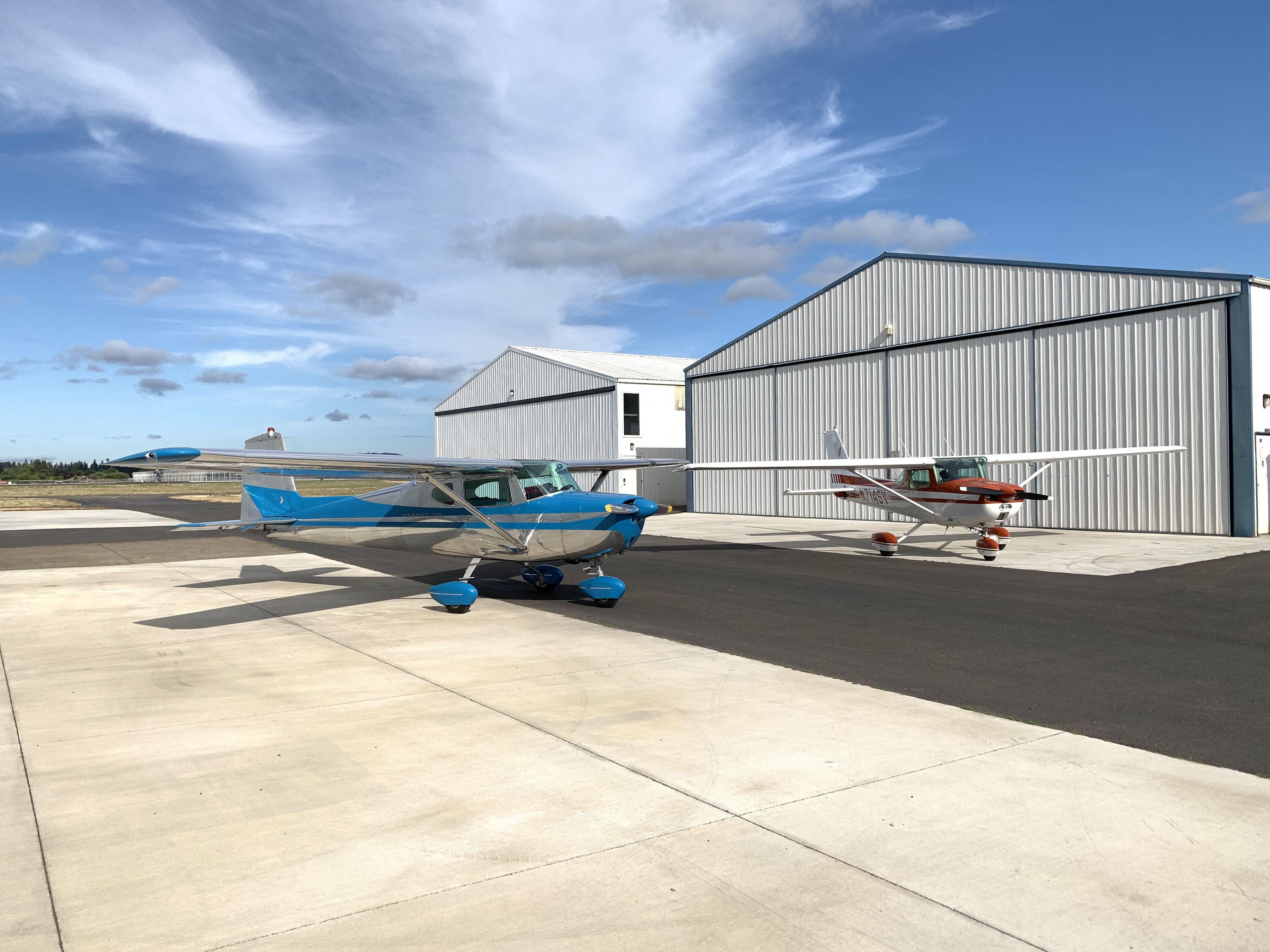Cessna 172 Review: 6 decades after its introduction, Cessna has chosen not to change anything on the Skyhawk. Why should they?
Is it just me, or does the Skyhawk seem younger? Take away the panel, paint, and interior and you might mistake a 2014 for a 1964 model if both airplanes were in bare aluminum and parked on the ramp. But while the current model’s configuration is physically very similar to that of the older models, the 2014 172S is a very different animal. In this Cessna 172 review, we’ll discuss how.
No, we’re not planning to detail a half-century of Skyhawk changes. We’re more interested in what the 172 has become than what it used to be. We’ll also skip any discussion of comparative price, as price is always relative.
Before you scoff and allege that the 21st century Skyhawk represents 20th century technology in contrast to the Cirrus SR 20/22, Diamond Star, and even Cessna’s own Corvalis 350/400, consider that what went before (and what still remains) has an undeniably strong attraction for many pilots.
Right up front, the 172/Skyhawk is the most successful airplane in the world, with more than 43,000 units delivered. Since the company restarted production in 1997, Cessna has sold some 4500 new generation Skyhawks of all descriptions. At an average $175,000/unit, that represents just under $800 million in sales. It’s safe to say, the Skyhawk’s glass is definitely more than half-full.
Cessna Skyhawk Review: Looking at a 2014 Skyhawk
The 2014 Skyhawk S continues the tradition of the 172, and it is the final recipient of the power revolution. The original airplane was born with a 145-hp, O-300 Continental engine. Cessna then transitioned to a 150-hp Lycoming O-320 power plant. In 1977, the company pushed the O-320’s power to 160 hp, before the new generation Skyhawk settled on 180 hp with an injected Lycoming IO-360. (Yes, there was a 180-hp model back in the 1980s—the Cutlass—but relatively few were built.) The former 160-hp 172R was available in 2008, but few were sold, and Cessna officially discontinued the lower-powered airplane for model year 2009.
After 30 years of writing about each subsequent Skyhawk, it might seem tough to find anything new to say. The truth is, however, love ‘em or not, Cessna’s durable, everyman’s single is an all-around good airplane. The Skyhawk is a little like the Toyota Camry (an American car, by the way, for the benefit of xenophobes.) It’s always been such a good design – in so many ways – that even its detractors have to acknowledge its strengths.
The simple fact remains that even if an airplane isn’t outstanding in any one category, there are few San Andreas-level faults in general aviation designs. The Skyhawk may not be the fastest, the quickest climber, the best load lifter, or even the cheapest, but as a whole, it has enough high marks to come out near the top in any competition. Case in point, my friend Keke Rosberg won the 1982 Formula One auto racing championship despite having placed first only once in the series’ 20 races.
Skyhawks, when regular pilots conduct a Cessna 172 review, have long been regarded as perhaps the premier, entry-level, family airplane, a reasonable 2+2 machine with reduced fuel and a forgiving two-seater in full fuel mode. Indeed, in addition to their use as rental leasebacks, Skyhawks remain among the most popular trainers in general aviation.
Like many of you, I’ve logged my share of hours in 172s of various vintage, flying some across the Atlantic and pedaling others on local hops when my airplane was in the shop. I may have a slightly different perspective than some pilots, however, as I’m fortunate to fly virtually all the competition every few years. While that definitely doesn’t give me a corner on ultimate truth, it does impart a certain perspective of the relative merits of a given design.
Better still; the lady in my life is a low-time private pilot who’s also had a chance to compare a number of airplanes in pursuit of her ticket—and, sometimes, just for the heck of it. In the short span of three years, Dr. Peggy Herrera-Cox, veterinarian extraordinaire and enthusiastic aviator, has flown about a dozen models, including all three new Cessnas (the Skyhawk S, T-Skylane and T-206), a Piper Archer and Malibu, a Beech F33A Bonanza, a Mooney Executive, and a Marchetti SF-260. Plus, probably a few others I’ve forgotten.
“From a student pilot’s perspective, the Skyhawk is an extremely simple airplane to fly in almost every respect,” said Herrera. “I was lucky to start my training in an air-conditioned, 2008 model with a G1000 flat panel display. The Skyhawk couldn’t be more straightforward, and I can certainly understand why it’s such a popular trainer. Control response is slow and gentle, the flaps are very effective, and stall speed is so low that nothing happens very fast in the pattern.
“That’s an important advantage for new students having trouble keeping up with the airplane, especially during landing,” Herrera continued. “I’d love to have ropes on the front of the airplane like the Goodyear Blimp, so a ground crew could help me land, but short of that, the Skyhawk has to be one of easiest machines to put back on the ground.” Herrera feels the most challenging aspect of the newer Skyhawks is the G1000 glass panel. “It’s a little overwhelming until you understand the logic, but the technology is impressive,” she said. “Still, it’s a challenge to deal with both the avionics technology and the airplane right out of the gate.”
Cessna hasn’t changed the airplane’s internal dimensions much over the years, which makes a Cessna 172 review the. The cabin is 39.5 inches across by 48 inches high, so you’re better off being tall than wide. In fairness, the door panels are recessed at the armrest to accommodate elbows. For shorter people, like Herrera, the Skyhawk’s tall panel presents a bit of a challenge, but at least both front seats are vertically adjustable as partial compensation. It’s relatively easy to climb aboard, and the AmSafe seatbelts/air bags spring from the center to attach at the doors rather than the other way around. In other words, you’d best fasten the belts before closing the doors!
Once you’re properly perched in the left seat, the view is fairly good. The Skyhawk’s tricycle gear provides a reasonably stable ride on the ground with little need for brakes to steer the airplane.
With 180 hp out front, the Skyhawk S boasts a 730 fpm climb at gross, so students, owners, and renters alike can score decent climb from sea level most of the time. Similarly, the airplane is adept at training from semi-high-altitude locations such as Albuquerque, Denver, Salt Lake, and Reno. Service ceiling is 14,000 feet, so cruise can be as tall as 10,500 without an especially labored climb.
Max cruise comes at 8000 feet, however. The NACA 2412 airfoil is optimized more for climb than cruise, but the airplane will still generate about 125 knots if conditions are willing and you’re doing everything right.
Specific fuel consumption (sfc) is fairly immutable, and the Skyhawk’s durable IO-360 scores about .43 lbs/hp/hr. From that, it’s fairly easy to calculate fuel burn at 75% (135 hp), 65% (117 hp) and 55 % power (99 hp). The pure numbers work out to 9.7 gph, 8.4 gph, and 7.1 gph respectively. If that’s too many numbers, just think of burn as 10, 9 and 8 gph respectively, and you’ll be on the safe side.
Despite their high use rate, Skyhawks benefit from an excellent safety record. The airplane’s gross is only 2550 pounds and drag is sufficient to keep speed low enough so that even full control deflection shouldn’t break anything. As Peggy Herrera described above, students and owners love the airplane. That’s, in part, a function of how many cheeks it can turn to the hands of time.
The first modern Skyhawk was the first three-passenger Cessna with four seats installed. Today, a typically-equipped airplane sports a payload of about 475 pounds, easily enough for two folks up front plus one or two munchkins in back. Full fuel is 53 gallons, so if you leave 20 gallons in the truck (with about 2.5 hours endurance plus reserve remaining), payload only increases to about 600 pounds, still not four folks worth.
The good news is that pilots are rarely tempted to fly a full seats/full tanks mission in a Skyhawk, though the new glass panel and gee-whiz Garmin G700 autopilot would make the trip next to automatic.
One trick that’s fun in a Skyhawk (if the load isn’t too heavy) is a short field takeoff. The technique is simple: power to the stop against locked brakes, release the binders when the power peaks, count to three, lever in two notches of flaps, and rotate at 35 knots. If you do it right, the airplane will transition to the sky in less than 800 feet.
Similarly, if you’re willing to use the bush pilot’s 1.2 Vso approach speed, the 172’s low stall speed allows for short field landings. Approach at 57 knots rather than the recommended 65 knots, and you can ground the airplane and brake to a stop in less than 500 feet. Of course, the usual proviso applies: don’t try this at home unless you’re very familiar with the stall characteristics and the wind is steady and right down the runway.
The Skyhawk has aged better than Heather Locklear. It may not win the swimsuit competition, but in a Cessna 172 review, along with the Cirrus SR-22, the venerable 172 has proven to be one of the airplanes most pilots buy most often.
Specifications & Performance – Cessna Skyhawk S
All specs and performance numbers are drawn from official sources, often the aircraft flight manual or the manufacturer’s web site.
Cessna 172 Review: Specifications
Engine make/model: Lyc IO-360
Horsepower @ altitude: 180
Horsepower on takeoff: 180
TBO – hours: 2000
Fuel type: 100LL
Propeller: McCauley FP
Landing gear type: Tri/Fxd
Gross ramp weight (lbs): 2558
Max takeoff weight (lbs): 2550
Std empty weight (lbs): 1717
Useful load – std (lbs): 841
Usable fuel – std (gal/lbs): 53/318
Payload – full std fuel (lbs): 523
Wingspan: 36’ 1”
Overall length: 27’ 2”
Height: 8’ 11”
Wing area (sq ft): 174
Wing loading (lbs/sq ft): 14.7
Power loading (lbs/hp): 14.2
Wheel size: 6.00 x 6
Seating capacity: 4
Cabin doors: 2
Cabin width (in): 39.5
Cabin height (in): 48
Baggage cap (cu ft): 30
Performance
Cruise speed (kts): 75% 126
Fuel Consumption (gph): 75% 9.7
Best rate of climb, SL (fpm): 730
Maximum Operating Altitude (ft): 14,000
Stall – Vso (kts): 47
TO ground roll (ft): 945
TO over 50 ft (ft): 1633
Ldg ground roll (ft): 550
Ldg over 50 ft (ft): 1335






